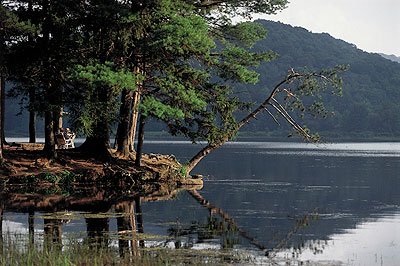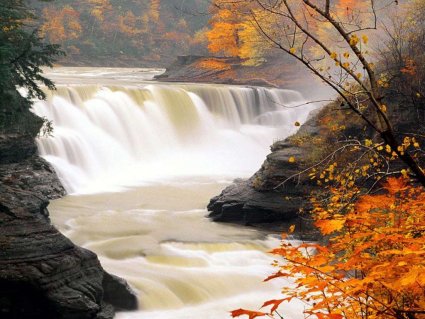US State of New York
New York is a state in the Northeastern region of the United States. New York is the 27th-most extensive, the third-most populous, and the seventh-most densely populated of the 50 United States. New York is bordered by New Jersey and Pennsylvania to the south and by Connecticut, Massachusetts and Vermont to the east. The state has a maritime border with Rhode Island east of Long Island, as well as an international border with the Canadian provinces of Ontario to the west and north, and Quebec to the north. The state of New York is often referred to as New York State, so as to distinguish it from New York City.
New York City, with a Census-estimated population of over 8.3 million in 2012, is the most populous city in the United States. Alone, it makes up over 40 percent of the population of New York State. It is known for its status as a center for finance and culture and for its status as the largest gateway for immigration to the United States. New York City attracts considerably more foreign visitors than any other US city. Both the state and city were named for the 17th century Duke of York, future King James II of England.
New York was inhabited by various tribes of Algonquian and Iroquoian speaking Native Americans at the time Dutch settlers moved into the region in the early 17th century. In 1609, the region was first claimed by Henry Hudson for the Dutch. Fort Nassau was built near the site of the present-day capital of Albany in 1614. The Dutch soon also settled New Amsterdam and parts of the Hudson River Valley, establishing the colony of New Netherland. The British took over the colony by annexation in 1664.
The borders of the British colony, the Province of New York, were roughly similar to those of the present-day state. About one third of all the battles of the Revolutionary War took place in New York. The state constitution was enacted in 1777. New York became the 11th state to ratify the United States Constitution, on July 26, 1788.
New York covers 54,556 square miles (141,300 km2) and ranks as the 27th largest state by size.[3] The Great Appalachian Valley dominates eastern New York and contains the Lake Champlain Valley as its northern half and the Hudson Valley as its southern half within the state. The rugged Adirondack Mountains, with vast tracts of wilderness, lie west of the Lake Champlain Valley. The Hudson River begins at Lake Tear of the Clouds and flows south through the eastern part of the state without draining Lakes George or Champlain. Lake George empties at its north end into Lake Champlain, whose northern end extends into Canada, where it drains into the Richelieu River and then ultimately the Saint Lawrence River. Four of New York City's five boroughs are situated on three islands at the mouth of the Hudson River: Manhattan Island; Staten Island; and Long Island, which contains Brooklyn and Queens on its western end.
Most of the southern part of the state is on the Allegheny Plateau, which rises from the southeast to the Catskill Mountains. The western section of the state is drained by the Allegheny River and rivers of the Susquehanna and Delaware systems. The Delaware River Basin Compact, signed in 1961 by New York, New Jersey, Pennsylvania, Delaware, and the federal government, regulates the utilization of water of the Delaware system. The highest elevation in New York is Mount Marcy in the Adirondacks.
New York's borders touch (clockwise from the west) two Great Lakes (Erie and Ontario, which are connected by the Niagara River); the provinces of Ontario and Quebec in Canada; Lake Champlain; three New England states (Vermont, Massachusetts, and Connecticut); the Atlantic Ocean, and two Mid-Atlantic states, New Jersey and Pennsylvania. In addition, Rhode Island shares a water border with New York. New York is the only state that touches both the Great Lakes and the Atlantic Ocean, and is the second-largest of the original Thirteen Colonies.
In contrast with New York City's urban atmosphere, the vast majority of the state's geographic area is dominated by farms, forests, rivers, mountains, and lakes. New York's Adirondack Park is the largest state park in the United States. It is larger than the Yellowstone, Yosemite, Grand Canyon, Glacier and Olympic National Parks combined. New York established the first state park in the United States at Niagara Falls in 1885. Niagara Falls, on the Niagara River as it flows from Lake Erie to Lake Ontario, is a popular attraction.
Upstate and downstate are often used informally to distinguish New York City or its greater metropolitan area from the rest of New York State. The placement of a boundary between the two is a matter of great contention. Unofficial and loosely defined regions of Upstate New York include the Southern Tier, which often includes the counties along the border with Pennsylvania, and the North Country, which can mean anything from the strip along the Canadian border to everything north of the Mohawk River.


Education in New York State
The University of the State of New York oversees all public primary, middle-level, and secondary education in the state, while the New York City Department of Education manages the public school system in New York City. In 1894, reflecting general racial discrimination, the state passed a law that allowed communities to set up schools for children of African-American descent. In 1900, the state passed another law requiring integrated schools.
At the post-secondary level, the statewide public university system is the State University of New York commonly referred to as SUNY. New York City also has its own City University of New York which is additionally funded by the city. The SUNY system consists of 64 community colleges, technical colleges, undergraduate colleges, and doctoral-granting institutions including several universities. The four SUNY university centers, offering a wide array of academic programs, are University at Albany, Binghamton University, University at Buffalo and Stony Brook University.
In addition there are many notable private universities, including the oldest Catholic institution in the Northeast, Fordham University. New York is home to both Columbia University in New York City and Cornell University in Ithaca, making it the only state to contain more than one Ivy League school. Syracuse University is located in the City of Syracuse in Central New York. West Point, the service academy of the U.S. Army is located just south of Newburgh, on the banks of the Hudson River.
During the 2007–2008 school year, New York spent more per pupil on public education than any other state.
From Wikipedia












